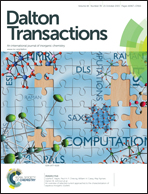Self-assembled copper(ii) metallacycles derived from asymmetric Schiff base ligands: efficient hosts for ADP/ATP in phosphate buffer†
Abstract
Novel asymmetric Schiff base ligands 2-{[3-(3-hydroxy-1-methyl-but-2-enylideneamino)-2,4,6-trimethylphenylimino]-methyl}-phenol (H2L1) and 1-{[3-(3-hydroxy-1-methyl-but-2-enylideneamino)-2,4,6-trimethylphenylimino]-methyl}-naphthalen-2-ol (H2L2) possessing dissimilar N,O-chelating sites and copper(II) metallacycles (CuL1)4 (1) and (CuL2)4 (2) based on these ligands have been described. The ligands and complexes have been thoroughly characterized by satisfactory elemental analyses, and spectral (IR, 1H, 13C NMR, ESI-MS, UV/vis) and electrochemical studies. Structures of H2L2 and 1 have been unambiguously determined by X-ray single crystal analyses. The crystal structure of H2L2 revealed the presence of two distinct N,O-chelating sites on dissimilar cores (naphthalene and β-ketoaminato groups) offering a diverse coordination environment. Metallacycles 1 and 2 having a cavity created by four Cu(II) centres coordinated in a homo- and heteroleptic fashion with respective ligands act as efficient hosts for adenosine-5′-diphosphate (ADP) and adenosine-5′-triphosphate (ATP) respectively, over other nucleoside polyphosphates (NPPs). The disparate sensitivity of these metallacycles toward ADP and ATP has been attributed to the size of the ligands assuming diverse dimensions and spatial orientations. These are attuned for π–π stacking and electrostatic interactions suitable for different guest molecules under analogous conditions, metallacycle 1 offers better orientation for ADP, while 2 for ATP. The mechanism of the host–guest interaction has been investigated by spectral and electrochemical studies and supported by molecular docking studies.


 Please wait while we load your content...
Please wait while we load your content...